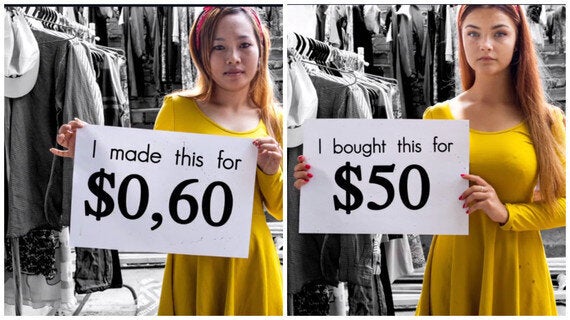
Today I commit to myself to look at the garment manufacturing information label before I buy any item from any retailer. I have already started to consume less a couple of years ago when I started questioning myself if having more is actually doing more harm. After the Rana Plaza factory collapse in Bangladesh in 2013, killing more than 1100 people (!), everyone was talking about the British discount clothing retailer Primark. It is natural to assume that the £3 T-Shirt must be made in awful conditions. I used to shop my 'essential basics' at Primark now and then but from then on I stopped completely. However, when I looked into the story or all the other stories in depth, I understood that Primark was just a tip of the iceberg (and just one of a few fashion retailers that actually took responsibility of what happened). There were at least 23 fashion manufacturers using local work force in that chain of sweatshops where Bangladeshi workers were slaving 19 hours per day in awful conditions. Some of the brands (including Primark) have committed to repay affected families and improve their working conditions but regardless that nothing much has actually changed since in the global rotten fashion consumerism. Unfortunately, it doesn't even have to be the cheapest item on a high-street to cause pain to a real person sewing it. Some designer houses use the same factories as let's say H&M, United Collors of Benetton, Primark or Zara.
If your fashion label says made in Cambodia/Bangladesh/Vietnam, etc. be sure you are contributing to the human slavery. It is very difficult to relate to the fact thus relating to the story is a way to go. My friend Ausra told me about the Norvegian reality TV project SWEATSHOP by Aftenposten.no. Three Norvegian youngsters were selected to participate in a lifetime journey to Cambodia: Frida, Ludvig and Anniken (who is one of the most influential fashion bloggers in Norway) went on a trip to Cambodia that changed their lives. They are just ordinary fashion consumers of their age group so it's a perfect sample group. They went to Cambodia to see and experience the working conditions of sweatshop workers making their clothes by let's say H&M. The rest is the history - it is pretty difficult to find the right words to describe their experiences and relive the emotions but it is very healthy to watch it yourself.
When I launched Fashion Bloc, that helps independent fashion houses and designers from former Soviet countries access international audience, I knew I was going to work with the designers and feature the designs that are designed AND made locally in Europe or by the designers themselves (wherever in the world they were based at the moment). To be completely honest, in the beginning it was more related to the urge to demonstrate a good production quality but eventually it has also become a mission to contribute to the conscious consumerism. Running Fashion Bloc is in a way helping independent designers be seen but also helping independent consumers be conscious. Made in Europe is not a concept of pride anymore. Made locally in Europe is a concept of equality, fairness, and economical support. Supporting independent fashion designers and being conscious of what you are wearing (carefully considering how much of the stuff you buy you actually need) could really make you feel better and contribute to the society. It is indeed the same as stop wearing fur, eating meat or buying 'caged meat'. It is your choice.
One may argue that sweatshops or as they call them factories in countries such as Cambodia contribute to their economical wellbeing where clothing manufacturing industry is one of the biggest export industries. No one in their right mind would argue with that but the obvious, well-known and public fact is - sweatshop workers are slaving there. Same as chicken packed in a cage (for those of you who chose to eat organic, free range eggs, etc.). The difference between the two is kind of obvious - the sweatshop workers are human beings who literally sweat there (most factories don't have air fans, not even talking about air conditioners), and often work until they faint of exhaustion or dehydration. I know it is quite difficult to relate to the written words thus I urge you once again to watch the aforementioned documentary. If we can't really stop people from working and governments from making (as little as it is) money from the fashion retail industry, we can at least try and be the change we want to see in the world.
There are quite a few fair-trade, conscious consumerism, slow fashion campaigners, manufacturers, brands, ambassadors and the change is actually happening (very slowly though). We are all a part of this. I think it is never too late to sit and think about the sentence that was pronounced by one of the participants of the reality show (and she was only 17!): 'We are rich just because they are poor'. 'Rich' is relative here but in the end, we can afford tons of clothes (be it fast fashion or some designer brands) just because they make them for almost free. What would happen if you would have 1 T-Shirt for the price of 3? Perhaps some 19 year-old who works in a factory to support her 8 person family could get a free bottle of water for her working day.
